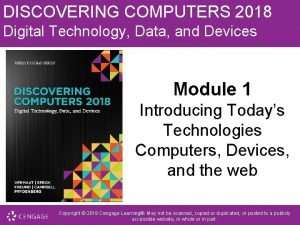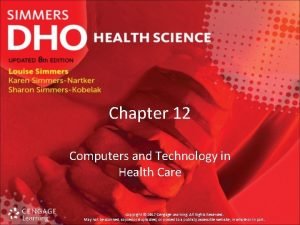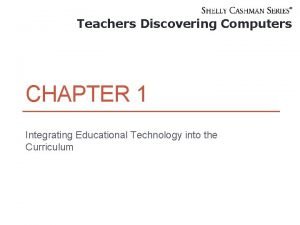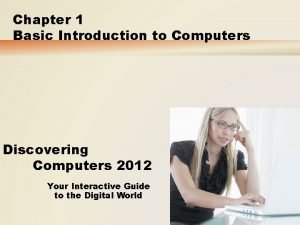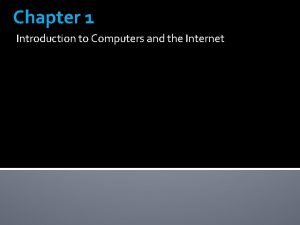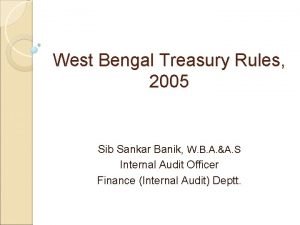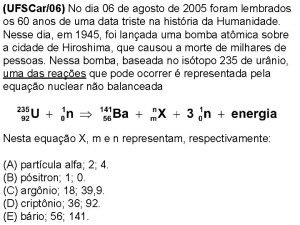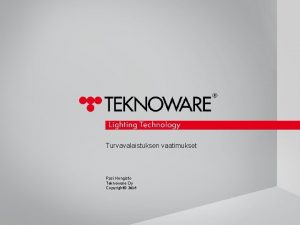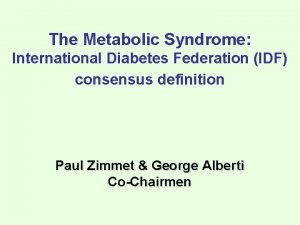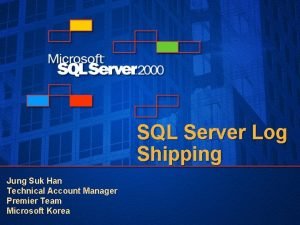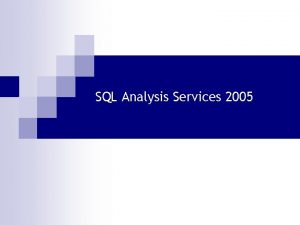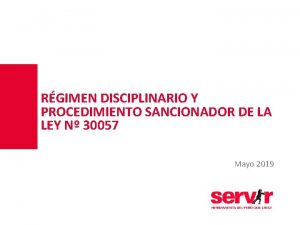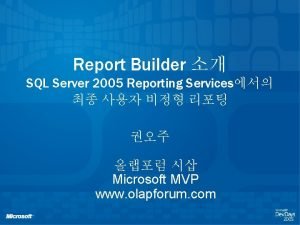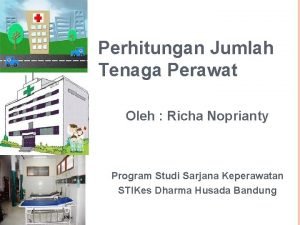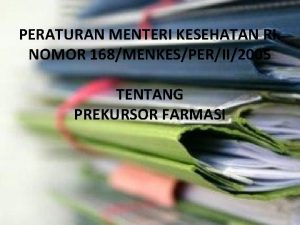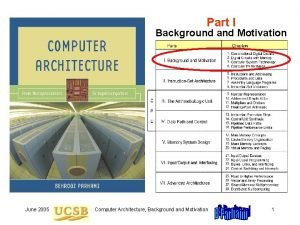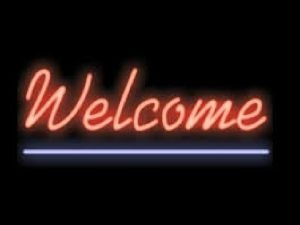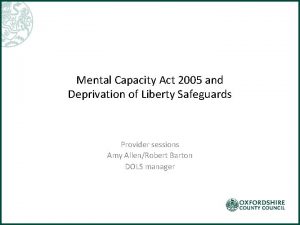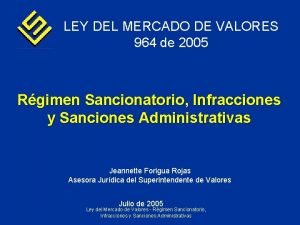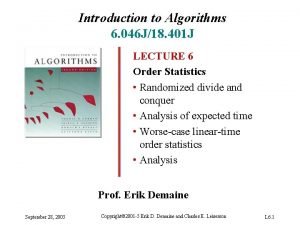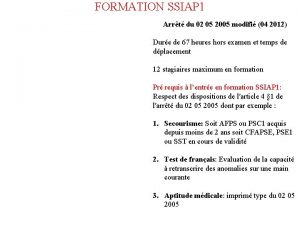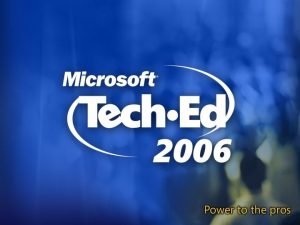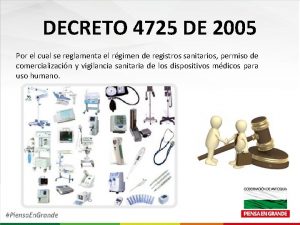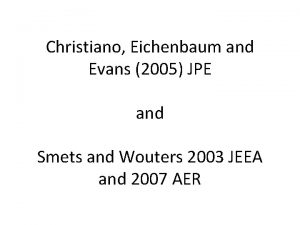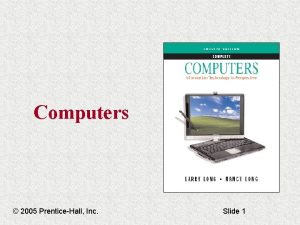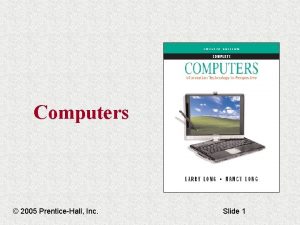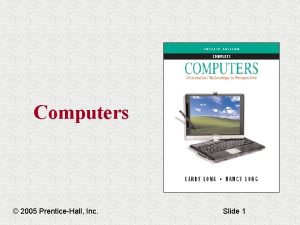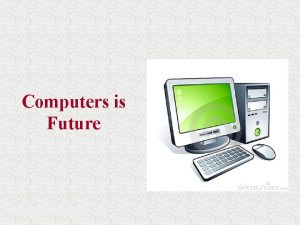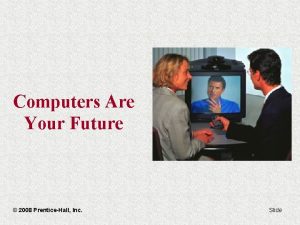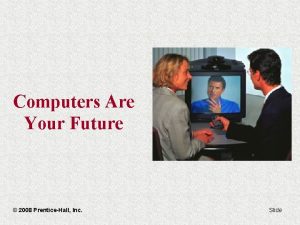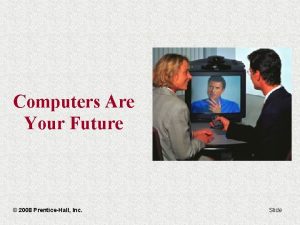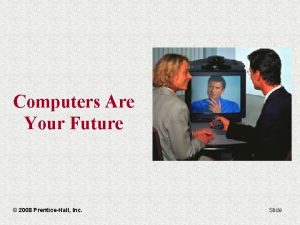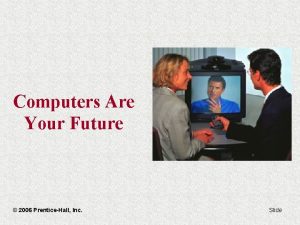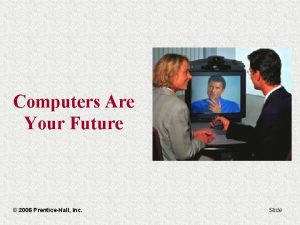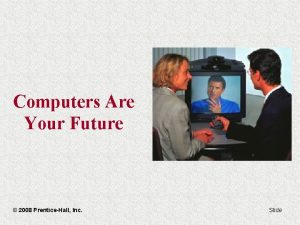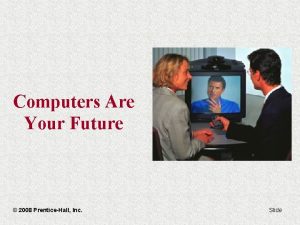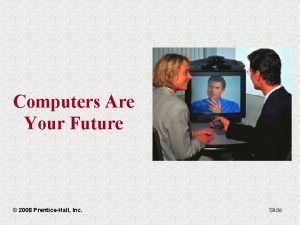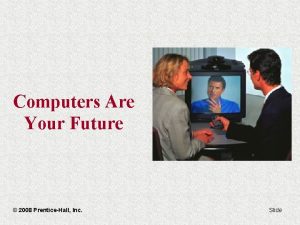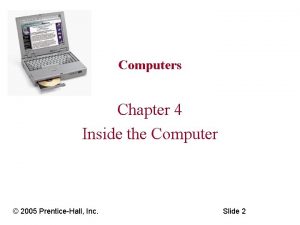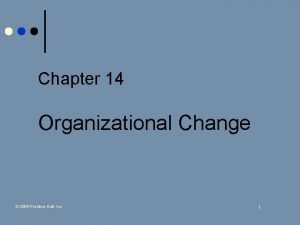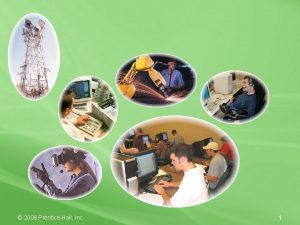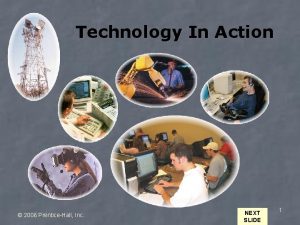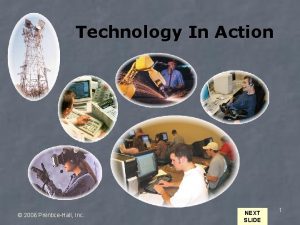Computers 2005 PrenticeHall Inc Slide 1 Computers Chapter



















































- Slides: 51

Computers © 2005 Prentice-Hall, Inc. Slide 1

Computers Chapter 6 Networks and Networking © 2005 Prentice-Hall, Inc. Slide 2

Computers Chapter 6 – Networks and Networking Objectives ü Apply the concept of connectivity to your life ü Understand data communications hardware ü Identify data transmissions services üUnderstand the various network topologies üRecognize the potential of home networking © 2005 Prentice-Hall, Inc. Slide 3

Computers Networks and Networking Our Wired World ü Connectivity – the degree to which software, hardware, and databases are functionally linked © 2005 Prentice-Hall, Inc. Slide 4

Computers Networks and Networking Our Wired World ü Cooperative processing ü Intracompany networking – cooperation within the company ü Intercompany networking – cooperation with other companies and customers © 2005 Prentice-Hall, Inc. Slide 5

Computers Networks and Networking Our Wired World ü Intranet –internal network based on Internet technology ü Extranet – an extension of an intranet, partially available to customers and suppliers © 2005 Prentice-Hall, Inc. Slide 6

Computers Networks and Networking Our Wired World ü Virtual Private Network (VPN) – network transmissions are tunneled through the Internet ü Tunneling – one network uses another to send data © 2005 Prentice-Hall, Inc. Slide 7

Computers Networks and Networking Data Communications Hardware üData communications or telecommunications – distribution of data © 2005 Prentice-Hall, Inc. Slide 8

Computers Networks and Networking Data Communications Hardware ü Server computers – central computers that control the network ü Client computers – computers, linked to a server, that create the network © 2005 Prentice-Hall, Inc. Slide 9

Computers Networks and Networking Data Communications Hardware ü Proxy server computers – handle some requests, hand others to the actual server computers © 2005 Prentice-Hall, Inc. Slide 10

Computers Networks and Networking Data Communications Hardware ü Telephone-link modem – converts analog signals to digital and digital signals to analog ü Analog – voice communication, such as over a telephone line üDigital – 1’s and 0’s used to represent data in a computer © 2005 Prentice-Hall, Inc. Slide 11

Computers Networks and Networking Data Communications Hardware ü Modem üInternal üExternal üVoice/data/fax modem © 2005 Prentice-Hall, Inc. Slide 12

Computers Networks and Networking Data Communications Hardware ü Cable modem – provides Internet access via cable television lines ü DSL (Digital Subscriber Line) – Internet access via special line provided by a telephone company ü Satellite modem – Internet access via communications satellite © 2005 Prentice-Hall, Inc. Slide 13

Computers Networks and Networking Data Communications Hardware ü Network interface card (NIC) – also called network card and network adapter üNeeded to connect a personal computer to a network üEthernet – de facto standard © 2005 Prentice-Hall, Inc. Slide 14

Computers Networks and Networking Data Communications Hardware ü Gateway – allows for communication between networks using different protocols ü Router – routes messages to the appropriate destination üGateway router – both functions in one device © 2005 Prentice-Hall, Inc. Slide 15

Computers Networks and Networking Data Communications Hardware ü Message üSource – device that sends the message üDestination – device that receives the message üHandshaking – router establishes the connection between the source and the destination © 2005 Prentice-Hall, Inc. Slide 16

Computers Networks and Networking Data Communications Hardware ü Network address – assigned to each computer on a network; used to send messages to the appropriate destination ü Backbone – the routers, gateways, and other equipment that link the computers of the network © 2005 Prentice-Hall, Inc. Slide 17

Computers Networks and Networking Data Communications Hardware ü Hub – expands the number of nodes on a network üHalf-duplex – data can only be sent in one direction at a time ü Switch – acts like a hub for a local area network (LAN) üFull-duplex – data can be sent in both directions at once © 2005 Prentice-Hall, Inc. Slide 18

Computers Networks and Networking Data Communications Hardware ü Terminals üVideo Display Terminal – input/output device üThin client – smart terminal, capable of some processing © 2005 Prentice-Hall, Inc. Slide 19

Computers Networks and Networking Data Communications Hardware ü Telephony – integration of telephones and computers © 2005 Prentice-Hall, Inc. Slide 20

Computers Networks and Networking Data Communications Hardware üAutomatic Teller Machine (ATM) – used in banking ü Point-of-Sale (POS) terminals – used in retail © 2005 Prentice-Hall, Inc. Slide 21

Computers Networks and Networking The Data Communications Channel üCommunications channel – media a message must pass through on a network üLine üLink üPipe © 2005 Prentice-Hall, Inc. Slide 22

Computers Networks and Networking The Data Communications Channel üTransmission media üMeasured in bits per second (bps) © 2005 Prentice-Hall, Inc. Slide 23

Computers Networks and Networking The Data Communications Channel üTwisted-pair wire üPOTS (plain old telephone services) üDigital Subscriber Line (DSL) üCat 5 cabling – uses four twisted pairs of wire; speeds of up to 100 M bps üCat 5 e cabling – speeds of up to 1 G bps © 2005 Prentice-Hall, Inc. Slide 24

Computers Networks and Networking The Data Communications Channel üCoaxial cable – high capacity channel, capable of speeds up to 10 M bps üFiber optic cable – carries data as electrical signals © 2005 Prentice-Hall, Inc. Slide 25

Computers Networks and Networking The Data Communications Channel üWireless communication ü Microwave signal – sent from one transmitter to another üRadio frequency (RF) signal – line-ofsight © 2005 Prentice-Hall, Inc. Slide 26

Computers Networks and Networking The Data Communications Channel üCommunications satellite – repeater for microwave transmissions in geosynchronous orbit üGeosynchronous orbit – 22, 300 miles above the earth © 2005 Prentice-Hall, Inc. Slide 27

Computers Networks and Networking The Data Communications Channel üWireless networks üAccess points – college campuses, coffee shops, local area networks üWi-Fi – approximately 300 foot range üBluetooth – approximately 30 foot range © 2005 Prentice-Hall, Inc. Slide 28

Computers Networks and Networking The Data Communications Channel üWireless Application Protocol (WAP) üInternet access standard for wireless devices such as cell phones © 2005 Prentice-Hall, Inc. Slide 29

Computers Networks and Networking The Data Communications Channel üFuture of wireless üMultichannel Multipoint Distribution Service (MMDS) üLocal Multipoint Distribution Service (LMDS) © 2005 Prentice-Hall, Inc. Slide 30

Computers Networks and Networking The Data Communications Channel üCommon carriers üExamples: AT&T, Sprint, MCI üPrivate line (leased line) – charge based on channel capacity and distance üSwitched line (dialup line) – time and distance charge © 2005 Prentice-Hall, Inc. Slide 31

Computers Networks and Networking The Data Communications Channel üCommunications protocols – rules established to govern the way data are transmitted in a computer network üAsynchronous transmission – data sent on an as-needed basis üSynchronous transmission – source and destination operate in timed synchronization © 2005 Prentice-Hall, Inc. Slide 32

Computers Networks and Networking Networks üNode – terminal, PC, or any device connected to a network © 2005 Prentice-Hall, Inc. Slide 33

Computers Networks and Networking Networks üTypes of Networks üPersonal Area Network (PAN) – connects cell phones or other electronics to the network üLocal Area Network (LAN) – nodes are in close proximity © 2005 Prentice-Hall, Inc. Slide 34

Computers Networks and Networking Networks üTypes of Networks üMetropolitan Area Network (MAN) – network that encompasses a city üWide Area Network (WAN) – nodes of the network are geographically distant © 2005 Prentice-Hall, Inc. Slide 35

Computers Networks and Networking Networks üLAN resources that can be shared ü Applications software ü Links to other LANs ü Communications capabilities ü I/O devices ü Storage devices ü Add-on boards © 2005 Prentice-Hall, Inc. Slide 36

Computers Networks and Networking Networks üLAN access methods ü Network Access Method – rule that a network uses to determine priorities üLogical topology © 2005 Prentice-Hall, Inc. Slide 37

Computers Networks and Networking Networks üEthernet – widely used network access method; uses Carrier Sense Multiple Access/Collision Detection (CSMA/CD protocol) üToken Access Method © 2005 Prentice-Hall, Inc. Slide 38

Computers Networks and Networking Networks üServers üFile server – stores programs and data to be shared via the network üPrint server – handles print jobs üCommunication server – provides access to other networks üLAN server – PC designed to be server © 2005 Prentice-Hall, Inc. Slide 39

Computers Networks and Networking Networks üLAN software üNetwork operating system (NOS) üPeer-to-peer (P 2 P) üDedicated server © 2005 Prentice-Hall, Inc. Slide 40

Computers Networks and Networking Networks üLAN software üPeer-to-peer LAN – all PCs are equal in the network üClient/server LAN – NOS resides on the server computer © 2005 Prentice-Hall, Inc. Slide 41

Computers Networks and Networking Networks üApplication software for LANs üClient/server LAN applications software üFront-end application software – user interface and applications software processed locally üBack-end application software – handles tasks associated with storage and maintenance of databases © 2005 Prentice-Hall, Inc. Slide 42

Computers Networks and Networking Networks üApplication software for LANs üDownload (server-to-client) üUpload (client-to-server) © 2005 Prentice-Hall, Inc. Slide 43

Computers Networks and Networking Networks üShared applications software üGroupware – allows a group of people to work on a project © 2005 Prentice-Hall, Inc. Slide 44

Computers Networks and Networking Networks üShared applications software üElectronic mail (e-mail) üInstant messaging üCalendar and scheduling üBrainstorming üShared whiteboarding © 2005 Prentice-Hall, Inc. Slide 45

Computers Networks and Networking Networks üShared applications software üSetting priorities üElectronic conferencing üElectronic forms © 2005 Prentice-Hall, Inc. Slide 46

Computers Networks and Networking Networks üHome network – small LAN in the home © 2005 Prentice-Hall, Inc. Slide 47

Computers Networks and Networking Networks üHome network technologies üWired üWireless üHome phoneline networking (Home. PNA or HPNA) – uses existing telephone lines to create the network üHome. Plug – uses electrical lines to connect computers in the network © 2005 Prentice-Hall, Inc. Slide 48

Computers Networks and Networking Networks üHome network decisions üHow many computers? Where will they be placed? üHow much do you want to spend? üWhat is your networking expertise? üDo you expect the network to grow? üWhat applications do you want to run? © 2005 Prentice-Hall, Inc. Slide 49

Computers Networks and Networking Networks üSteps to installing a home network üInstall network interface cards üSet up communication hardware üLink PCs to router/hub/switch üSet up network software üIdentify files/printers to be shared üSet up Internet connection sharing © 2005 Prentice-Hall, Inc. Slide 50

Computers Chapter 6 – Networks and Networking Lesson Summary • • • Apply the concept of connectivity to your life Understand data communications hardware Identify data transmission services Understand the various network topologies Recognize the potential of home networking © 2005 Prentice-Hall, Inc. Slide 51
 Basic dance steps in heel and toe polka
Basic dance steps in heel and toe polka Copyright 2005 pearson prentice hall inc
Copyright 2005 pearson prentice hall inc 2005 pearson prentice hall inc
2005 pearson prentice hall inc Slide and divide factoring method
Slide and divide factoring method Discovering computers 2018 chapter 1 ppt
Discovering computers 2018 chapter 1 ppt Test chapter 12 computers and technology in health care
Test chapter 12 computers and technology in health care Discovering computers 2018 chapter 1
Discovering computers 2018 chapter 1 Discovering computers
Discovering computers Computer programming chapter 1
Computer programming chapter 1 Computer programming chapter 1
Computer programming chapter 1 Computer oriented society
Computer oriented society Chapter 1 introduction to computers and programming
Chapter 1 introduction to computers and programming Chapter 1 introduction to computers and programming
Chapter 1 introduction to computers and programming Treasury rules 2005
Treasury rules 2005 Child rights act 2005 images
Child rights act 2005 images Mental capacity act 2005 summary
Mental capacity act 2005 summary 6 de agosto de 2005
6 de agosto de 2005 Sma 805/2005
Sma 805/2005 Idf metabolic syndrome
Idf metabolic syndrome Reportable irregularity template
Reportable irregularity template Supplytime 2005
Supplytime 2005 What are the 5 stages of the counseling process
What are the 5 stages of the counseling process How to monitor log shipping in sql server 2005
How to monitor log shipping in sql server 2005 Sql 2005 activity monitor
Sql 2005 activity monitor Microsoft sql server 2005 analysis services
Microsoft sql server 2005 analysis services 2005 sosyal bilgiler öğretim programı
2005 sosyal bilgiler öğretim programı Informe técnico 1005-2018-servir-gpgsc
Informe técnico 1005-2018-servir-gpgsc Whetten y cameron (2005)
Whetten y cameron (2005) Sql server 2005 report builder download
Sql server 2005 report builder download Rumus metode gillies
Rumus metode gillies Permenkes nomor 168 tahun 2005 mengatur tentang
Permenkes nomor 168 tahun 2005 mengatur tentang June 2005 calendar
June 2005 calendar Darna 1991
Darna 1991 On ne moque pas de dieu
On ne moque pas de dieu Existanxe
Existanxe Ncf curriculum framework 2005
Ncf curriculum framework 2005 Mental capacity act easy read
Mental capacity act easy read Mental capacity act 2005 summary
Mental capacity act 2005 summary Ley 964 de 2005
Ley 964 de 2005 2005/lml/18/8
2005/lml/18/8 S/2005 j18
S/2005 j18 Child rights act 2005 images
Child rights act 2005 images 02 05 2005
02 05 2005 Dubai 1960
Dubai 1960 Microsoft visual studio 2005 tools for applications - enu
Microsoft visual studio 2005 tools for applications - enu Pearson education limited 2005
Pearson education limited 2005 4725
4725 Christiano eichenbaum evans 2005
Christiano eichenbaum evans 2005 Elsevier 2005
Elsevier 2005 Biology 30 diploma
Biology 30 diploma Disability act 2005 citizens information
Disability act 2005 citizens information Apc 2005
Apc 2005




